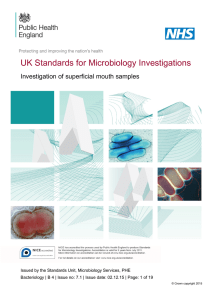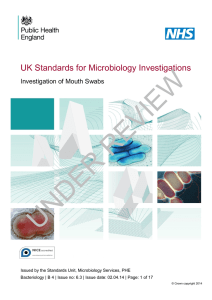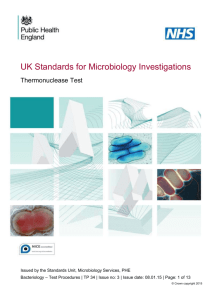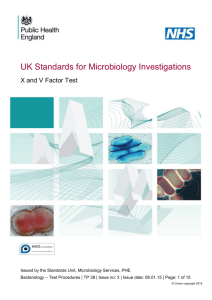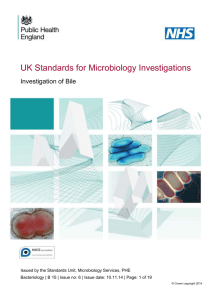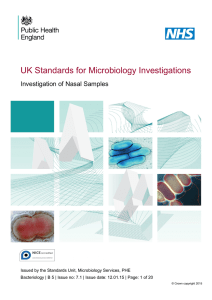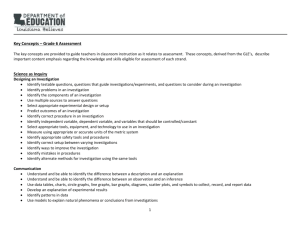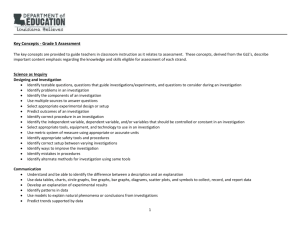B 4i7.1 November 2015
advertisement
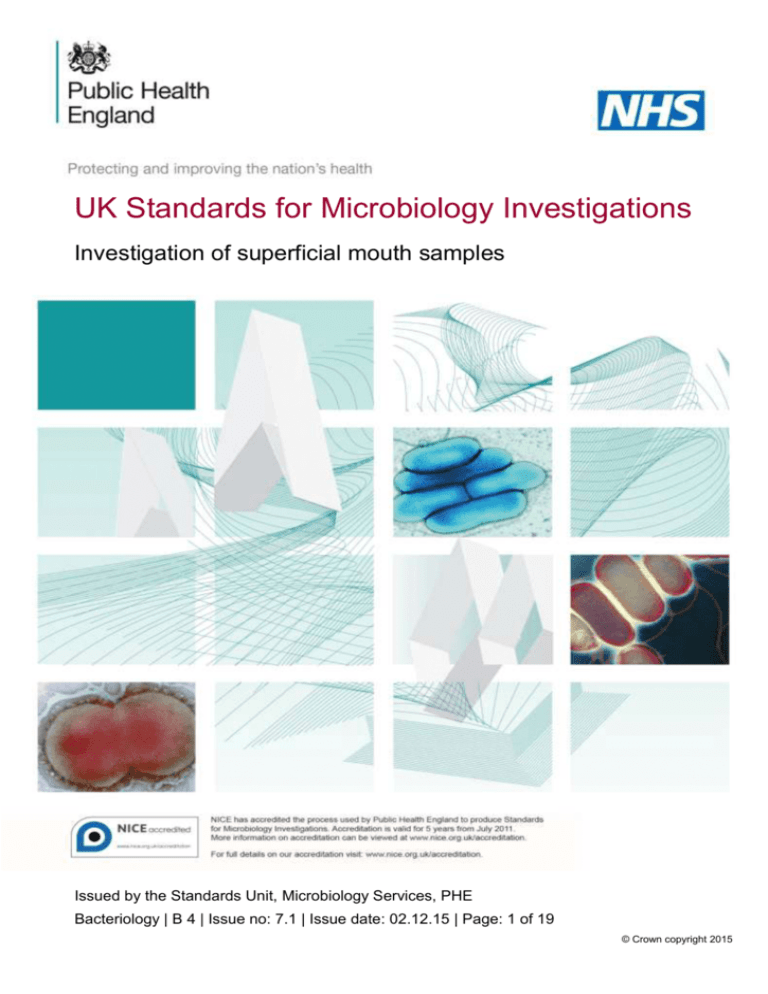
UK Standards for Microbiology Investigations Investigation of superficial mouth samples Issued by the Standards Unit, Microbiology Services, PHE Bacteriology | B 4 | Issue no: 7.1 | Issue date: 02.12.15 | Page: 1 of 19 © Crown copyright 2015 Investigation of superficial mouth samples Acknowledgments UK Standards for Microbiology Investigations (SMIs) are developed under the auspices of Public Health England (PHE) working in partnership with the National Health Service (NHS), Public Health Wales and with the professional organisations whose logos are displayed below and listed on the website https://www.gov.uk/ukstandards-for-microbiology-investigations-smi-quality-and-consistency-in-clinicallaboratories. SMIs are developed, reviewed and revised by various working groups which are overseen by a steering committee (see https://www.gov.uk/government/groups/standards-for-microbiology-investigationssteering-committee). The contributions of many individuals in clinical, specialist and reference laboratories who have provided information and comments during the development of this document are acknowledged. We are grateful to the medical editors for editing the medical content. We also acknowledge the Association of Clinical Oral Microbiologists for their considerable specialist input. For further information please contact us at: Standards Unit Microbiology Services Public Health England 61 Colindale Avenue London NW9 5EQ E-mail: standards@phe.gov.uk Website: https://www.gov.uk/uk-standards-for-microbiology-investigations-smi-qualityand-consistency-in-clinical-laboratories PHE publications gateway number: 2015424 UK Standards for Microbiology Investigations are produced in association with: Logos correct at time of publishing. Bacteriology | B 4 | Issue no: 7.1 | Issue date: 02.12.15 | Page: 2 of 19 UK Standards for Microbiology Investigations | Issued by the Standards Unit, Public Health England Investigation of superficial mouth samples Contents ACKNOWLEDGMENTS .......................................................................................................... 2 AMENDMENT TABLE ............................................................................................................. 4 UK SMI: SCOPE AND PURPOSE ........................................................................................... 5 SCOPE OF DOCUMENT ......................................................................................................... 7 INTRODUCTION ..................................................................................................................... 7 TECHNICAL INFORMATION/LIMITATIONS ........................................................................... 9 1 SAFETY CONSIDERATIONS .................................................................................... 10 2 SPECIMEN COLLECTION ......................................................................................... 10 3 SPECIMEN TRANSPORT AND STORAGE ............................................................... 11 4 SPECIMEN PROCESSING/PROCEDURE ................................................................. 11 5 REPORTING PROCEDURE ....................................................................................... 14 6 NOTIFICATION TO PHE, OR EQUIVALENT IN THE DEVOLVED ADMINISTRATIONS .................................................................................................. 15 APPENDIX: INVESTIGATION OF SUPERFICIAL MOUTH SAMPLES................................. 16 REFERENCES ...................................................................................................................... 17 Bacteriology | B 4 | Issue no: 7.1 | Issue date: 02.12.15 | Page: 3 of 19 UK Standards for Microbiology Investigations | Issued by the Standards Unit, Public Health England Investigation of superficial mouth samples Amendment table Each SMI method has an individual record of amendments. The current amendments are listed on this page. The amendment history is available from standards@phe.gov.uk. New or revised documents should be controlled within the laboratory in accordance with the local quality management system. Amendment no/date. 11/02.12.15 Issue no. discarded. 7 Insert issue no. 7.1 Section(s) involved Amendment 4.5.3 Culture media, conditions and organisms. Error in atmosphere column corrected. Amendment no/date. 10/20.10.15 Issue no. discarded. 6.3 Insert issue no. 7 Section(s) involved Amendment Whole document. Document restructured, rewritten and expanded to meet the requirements of the new scope. Hyperlinks updated to gov.uk. Title of the document. Changed to capture more sample types. Page 2. Updated logos added. Types of specimen. Saliva and oral rinses added in. Culture. Amended to include new sample types. References. Reviewed and updated. Bacteriology | B 4 | Issue no: 7.1 | Issue date: 02.12.15 | Page: 4 of 19 UK Standards for Microbiology Investigations | Issued by the Standards Unit, Public Health England Investigation of superficial mouth samples UK SMI: scope and purpose Users of SMIs Primarily, SMIs are intended as a general resource for practising professionals operating in the field of laboratory medicine and infection specialties in the UK. SMIs also provide clinicians with information about the available test repertoire and the standard of laboratory services they should expect for the investigation of infection in their patients, as well as providing information that aids the electronic ordering of appropriate tests. The documents also provide commissioners of healthcare services with the appropriateness and standard of microbiology investigations they should be seeking as part of the clinical and public health care package for their population. Background to SMIs SMIs comprise a collection of recommended algorithms and procedures covering all stages of the investigative process in microbiology from the pre-analytical (clinical syndrome) stage to the analytical (laboratory testing) and post analytical (result interpretation and reporting) stages. Syndromic algorithms are supported by more detailed documents containing advice on the investigation of specific diseases and infections. Guidance notes cover the clinical background, differential diagnosis, and appropriate investigation of particular clinical conditions. Quality guidance notes describe laboratory processes which underpin quality, for example assay validation. Standardisation of the diagnostic process through the application of SMIs helps to assure the equivalence of investigation strategies in different laboratories across the UK and is essential for public health surveillance, research and development activities. Equal partnership working SMIs are developed in equal partnership with PHE, NHS, Royal College of Pathologists and professional societies. The list of participating societies may be found at https://www.gov.uk/uk-standards-for-microbiology-investigations-smi-qualityand-consistency-in-clinical-laboratories. Inclusion of a logo in an SMI indicates participation of the society in equal partnership and support for the objectives and process of preparing SMIs. Nominees of professional societies are members of the Steering Committee and working groups which develop SMIs. The views of nominees cannot be rigorously representative of the members of their nominating organisations nor the corporate views of their organisations. Nominees act as a conduit for two way reporting and dialogue. Representative views are sought through the consultation process. SMIs are developed, reviewed and updated through a wide consultation process. Quality assurance NICE has accredited the process used by the SMI working groups to produce SMIs. The accreditation is applicable to all guidance produced since October 2009. The process for the development of SMIs is certified to ISO 9001:2008. SMIs represent a good standard of practice to which all clinical and public health microbiology Microbiology is used as a generic term to include the two GMC-recognised specialties of Medical Microbiology (which includes Bacteriology, Mycology and Parasitology) and Medical Virology. Bacteriology | B 4 | Issue no: 7.1 | Issue date: 02.12.15 | Page: 5 of 19 UK Standards for Microbiology Investigations | Issued by the Standards Unit, Public Health England Investigation of superficial mouth samples laboratories in the UK are expected to work. SMIs are NICE accredited and represent neither minimum standards of practice nor the highest level of complex laboratory investigation possible. In using SMIs, laboratories should take account of local requirements and undertake additional investigations where appropriate. SMIs help laboratories to meet accreditation requirements by promoting high quality practices which are auditable. SMIs also provide a reference point for method development. The performance of SMIs depends on competent staff and appropriate quality reagents and equipment. Laboratories should ensure that all commercial and in-house tests have been validated and shown to be fit for purpose. Laboratories should participate in external quality assessment schemes and undertake relevant internal quality control procedures. Patient and public involvement The SMI working groups are committed to patient and public involvement in the development of SMIs. By involving the public, health professionals, scientists and voluntary organisations the resulting SMI will be robust and meet the needs of the user. An opportunity is given to members of the public to contribute to consultations through our open access website. Information governance and equality PHE is a Caldicott compliant organisation. It seeks to take every possible precaution to prevent unauthorised disclosure of patient details and to ensure that patient-related records are kept under secure conditions. The development of SMIs is subject to PHE Equality objectives https://www.gov.uk/government/organisations/public-healthengland/about/equality-and-diversity. The SMI working groups are committed to achieving the equality objectives by effective consultation with members of the public, partners, stakeholders and specialist interest groups. Legal statement While every care has been taken in the preparation of SMIs, PHE and any supporting organisation, shall, to the greatest extent possible under any applicable law, exclude liability for all losses, costs, claims, damages or expenses arising out of or connected with the use of an SMI or any information contained therein. If alterations are made to an SMI, it must be made clear where and by whom such changes have been made. The evidence base and microbial taxonomy for the SMI is as complete as possible at the time of issue. Any omissions and new material will be considered at the next review. These standards can only be superseded by revisions of the standard, legislative action, or by NICE accredited guidance. SMIs are Crown copyright which should be acknowledged where appropriate. Suggested citation for this document Public Health England. (2015). Investigation of Superficial Mouth Samples. UK Standards for Microbiology Investigations. B 4 Issue 7. https://www.gov.uk/ukstandards-for-microbiology-investigations-smi-quality-and-consistency-in-clinicallaboratories Bacteriology | B 4 | Issue no: 7.1 | Issue date: 02.12.15 | Page: 6 of 19 UK Standards for Microbiology Investigations | Issued by the Standards Unit, Public Health England Investigation of superficial mouth samples Scope of document Type of specimen Mouth swab, saliva and oral rinse This SMI describes the processing, and bacteriological and mycological investigation of superficial mouth samples. Predominately mouth swabs but saliva and oral rinses are also covered. Infections of salivary glands (parotid, submandibular and sublingual) include bacterial and viral infections and are not covered in this SMI. This SMI should be used in conjunction with other SMIs. Introduction Infections of the oral mucosa usually present as acute conditions. Usually these arise from the colonising oral flora but can also result from a flare-up of a chronic low-grade infection. Oral mucosal infections are typically associated with biofilms formed on the inanimate surfaces present in the oral cavity such as the teeth and dentures. Infections of the gingiva (gingivitis, including acute ulcerative gingivitis) and periodontal tissues (periodontitis) are the most common forms of oral infection and processing specimens from these infections is covered by a separate SMI B 17 – Investigation of tissues and biopsies. Oral mucositis Oral mucositis is a painful complication of chemotherapy or head and neck radiotherapy, caused by direct cytotoxicity of the treatment regime. Super-infection usually with yeasts and oral bacteria can exacerbate the problem and microbiological examination can help to guide symptomatic treatment. Erythematous and pseudomembranous candidosis1,2 Erythematous and pseudomembranous candidosis are the most frequent clinical presentations of oral fungal infection. The infections may involve the mucosal surfaces of the cheeks, tongue (dorsal and ventral surfaces) and both hard and soft palates. The most common cause is Candida albicans. Candida species other than C. albicans such as Candida glabrata may also be isolated, either alone or in combination with C. albicans. This is especially common in the medically compromised or those with a history of prolonged antifungal therapy3,4. Atrophic candidosis (denture stomatitis) may occur in the palatal mucosa below the fitting surface of dentures, especially when patients sleep with their dentures in place and/or have xerostomia. Candida species other than C. albicans are important to identify, since they may demonstrate reduced susceptibility and clinical resistance to the first line anti-fungal agents and may be responsible for refractory or recurrent infections. Rarely, moulds may colonise and infect sinuses and result in palatal erosion. Specimens in the form of an oral rinse (known volume of sterile saline) are used to quantitatively determine colonisation or infection5. Bacteriology | B 4 | Issue no: 7.1 | Issue date: 02.12.15 | Page: 7 of 19 UK Standards for Microbiology Investigations | Issued by the Standards Unit, Public Health England Investigation of superficial mouth samples Angular cheilitis and peri-oral infections Angular cheilitis and peri-oral infections are common infections affecting the angles of the mouth and lips, usually caused by an intra-oral reservoir of infection, typically biofilms associated with denture stomatitis. Infection may be due to S. aureus, Candida species and/or Group A streptococci. It is common for dentate patients with angular cheilitis to have infection with both S. aureus and C. albicans in the labial commissure region. Swabs should be taken from the lesions themselves. Swabs should also be collected from relevant intra-oral sites eg denture-fitting surface and the anterior nares to identify sites of colonisation to be treated with eradication therapy, to reduce relapse rates. Staphylococcal mucositis6 Patients who are severely medically compromised and have reduced salivary flow, together with parenteral feeding, may develop staphylococcal mucositis caused by S. aureus. Enterobacteria may also play a role in severe cases. The erythematous changes in the oral mucosa may be indistinguishable clinically from candidosis, requiring the need for microbiological investigation. Results should be interpreted in a clinical context since asymptomatic carriage of S. aureus or Enterobacteria may occur. Strict regular oral hygiene measures are usually sufficient to resolve clinical symptoms. Systemic antibiotics are not usually required although may play an important role in the management of severe oral mucositis in some patient groups such as the terminally ill. Oral ulceration There are many non-infective causes of oral ulceration such as traumatic ulcers, recurrent aphthous ulcers, inflammatory conditions and malignant lesions. Infective causes of oral ulceration are commonly viral in origin (eg Herpes simplex). Uncommon bacterial causes of ulceration are syphilis and tuberculosis whilst other rare causes of oral ulceration include fungal infections such as histoplasmosis. Abscess and deep seated infections Abscess and deep seated infections (dental abscesses, and salivary gland abscesses) are dealt with in B 14 - Investigation of abscesses and deep seated wound infections. Osteomyelitis Osteomyelitis, including bacterial, mycobacterial and fungal osteomyelitis are dealt with in B 42 - Investigation of bone and soft tissue associated with osteomyelitis. Vincent’s angina Borrelia vincentii and Fusobacterium species are associated with the infection known as Vincent's angina. It is characterised by ulceration of the pharynx or gums and occurs in adults with poor mouth hygiene or serious systemic disease7. See B 9 – Investigation of throat related specimens. Bacteriology | B 4 | Issue no: 7.1 | Issue date: 02.12.15 | Page: 8 of 19 UK Standards for Microbiology Investigations | Issued by the Standards Unit, Public Health England Investigation of superficial mouth samples Technical information/limitations Limitations of UK SMIs The recommendations made in UK SMIs are based on evidence (eg sensitivity and specificity) where available, expert opinion and pragmatism, with consideration also being given to available resources. Laboratories should take account of local requirements and undertake additional investigations where appropriate. Prior to use, laboratories should ensure that all commercial and in-house tests have been validated and are fit for purpose. Selective media in screening procedures Selective media which does not support the growth of all circulating strains of organisms may be recommended based on the evidence available. A balance therefore must be sought between available evidence, and available resources required if more than one media plate is used. Specimen containers8,9 SMIs use the term “CE marked leak proof container” to describe containers bearing the CE marking used for the collection and transport of clinical specimens. The requirements for specimen containers are given in the EU in vitro Diagnostic Medical Devices Directive (98/79/EC Annex 1 B 2.1) which states: “The design must allow easy handling and, where necessary, reduce as far as possible contamination of and leakage from, the device during use and, in the case of specimen receptacles, the risk of contamination of the specimen. The manufacturing processes must be appropriate for these purposes”. Bacteriology | B 4 | Issue no: 7.1 | Issue date: 02.12.15 | Page: 9 of 19 UK Standards for Microbiology Investigations | Issued by the Standards Unit, Public Health England Investigation of superficial mouth samples 1 Safety considerations8-24 1.1 Specimen collection, transport and storage8-13 Use aseptic technique. Collect saliva and oral rinse specimens into appropriate CE marked leak proof containers and transport specimens in sealed plastic bags. Use tubes with transport medium for transporting swabs and transport in sealed plastic bags25. Transport each swab in transport medium in a CE marked container in a sealed plastic bag. Compliance with postal, transport and storage regulations is essential. 1.2 Specimen processing8-24 Containment Level 2. Laboratory procedures that give rise to infectious aerosols must be conducted in a microbiological safety cabinet16. Refer to current guidance on the safe handling of all organisms documented in this SMI. If there is histoplasma (and/or other relevant dimorphic pathogens causing oral ulceration) risk then contaminant level 3 is required using an appropriate cabinet. The above guidance should be supplemented with local COSHH and risk assessments. 2 Specimen collection 2.1 Type of specimens Mouth swab, saliva and oral rinse 2.2 Optimal time and method of collection26 For safety considerations refer to Section 1.1. Collect specimens before starting antimicrobial therapy where possible26. To assure that the preconditions of the sampling for oral infections are comparable it is advised that patients should not: 1. eat or drink within 2 hours 2. brush their teeth within 2 hours 3. use any mouth rinse of disinfectant within 2 hours prior to sampling If possible samples should be taken in the morning under fasting conditions. Unless otherwise indicated collect each swab for bacterial and/or fungal culture and place in appropriate transport medium25,27-30. Collect specimens other than swabs into appropriate CE marked leak proof containers and place in sealed plastic bags. Bacteriology | B 4 | Issue no: 7.1 | Issue date: 02.12.15 | Page: 10 of 19 UK Standards for Microbiology Investigations | Issued by the Standards Unit, Public Health England Investigation of superficial mouth samples Sample any lesions or inflamed areas using cotton tipped swabs. Samples of denture fitting surfaces should also be swabbed as these are more sensitive sites than the palatal mucosa to recover Candida species. The use of a tongue depressor or spatula may be helpful. Oral rinses can be useful to follow up level of colonisation. These are collected by rinsing with 10mL of sterile saline for one minute. 2.3 Adequate quantity and appropriate number of specimens26 Numbers and frequency of specimens collected depend on the clinical condition of patient. 3 Specimen transport and storage8,9 3.1 Optimal transport and storage conditions For safety considerations refer to Section 1.1. Specimens should be transported and processed as soon as possible 26. Collect mucosal swabs in transport medium which should be transported and processed as soon as possible. If processing is delayed, refrigeration is preferable to storage at ambient temperature. Oral rinses should be transported in a CE marked leak proof containers and placed in sealed plastic bags and processed as soon as possible. 4 Specimen processing/procedure8,9 4.1 Test selection Most mouth samples are swabs unless the patient is immunocompromised or has other clinical indications. Saliva samples may be collected for microbiological investigation and for other types of assessment. Increasingly saliva is being used as a sample for new diagnostic techniques, but also for assessing xerostomia and risk of dental caries. Care is needed to avoid contamination of these specimens and cross infection from these specimens. Sometimes culture is done with an exact volume of saliva in order to assess the count of a particular organism (eg S. mutans or lactobacilli per mL of the original saliva sample. 4.2 Appearance N/A 4.3 Sample preparation For safety considerations refer to Section 1.2. For oral rinses (saliva/mouth washings) centrifuge at 3200 rpm for 10 minutes. Decant supernatant into disinfectant and re suspend the deposit in 1mL PBS. This is now the neat sample. Inoculate 50µL onto a sabouraud agar plate using a hockey stick to spread out for single colonies and a columbia agar plate. Bacteriology | B 4 | Issue no: 7.1 | Issue date: 02.12.15 | Page: 11 of 19 UK Standards for Microbiology Investigations | Issued by the Standards Unit, Public Health England Investigation of superficial mouth samples For comparison it is sometimes useful to dilute neat sample 1:100 (0.1mL + 9.9mL PBS). Inoculate 50µL onto a Columbia Blood Agar and use a hockey stick to spread out. A MacConkey/CLED plate may also be useful. 4.4 Microscopy Direct microscopic examination with Calcofluor staining may be helpful if histoplasma or mould infection is suspected. 4.5 Culture and investigation Inoculate each agar plate using a sterile loop or a loopful of liquid (Q 5 - Inoculation of culture media for bacteriology). For the isolation of individual colonies, spread inoculum with a sterile loop. 4.5.1 Culture media, conditions and organisms Clinical details/ Specimen Standard media conditions Oral candidosis Fungal infection Mouth swab, Saliva and oral rinse Oral erythema Sabouraud agar Incubation Temp °C Atmos Time 35-37 Air 40-48hr* Cultures read Target organism(s) Daily C. albicans, Non-albicans yeasts Blood agar 35-37 CO2 16-24hr daily Group A, strep, S. aureus, 5-10% Denture stomatitis Coliforms Angular cheilitis Mouth ulcer Clinical details/ Specimen Supplementary media conditions Oral mucositis Immunoco mpromised patients Mouth swab, Saliva and oral rinse MacConkey/CL ED agar Chromogenic agar Incubation Cultures read Target organism(s) Temp °C Atmos Time 35-37 Air 16-24hr daily Coliforms and nonfermentative gram negatives 35-37 Air 16-24hr daily Candida species *If Histoplasmosis is suspected the length of incubation should be extended and carried out in Containment Level 3. If an unusual fungal infection is suspected a second Sabouraud plate should be set up at 30°C and incubation time extended. 4.6 Identification Refer to individual SMIs for organism identification. Bacteriology | B 4 | Issue no: 7.1 | Issue date: 02.12.15 | Page: 12 of 19 UK Standards for Microbiology Investigations | Issued by the Standards Unit, Public Health England Investigation of superficial mouth samples 4.6.1 Minimum level of identification in the laboratory Yeasts Yeasts level Patients showing treatment failure require a full identification. Staphylococcus aureus species level Lancefield group A streptococcus species level Enterobacteriaceae species "coliform" level if dominant growth Organisms may be further identified if this is clinically or epidemiologically indicated. Immunocompromised Patients Candida species species level Aspergillus species and other moulds genus level Staphylococcus aureus species level Lancefield group A streptococcus species level Coliforms Coliforms level or if clinically indicated species level Pseudomonas Pseudomonas level if dominant growth or if clinically indicated species level Acinetobacter Acinetobacter level if dominant growth or if clinically indicated species level Stenotrophomonas Stenotrophomonas level if dominant growth or if clinically indicated species level 4.7 Antimicrobial susceptibility testing Refer to British Society for Antimicrobial Chemotherapy (BSAC) and/or EUCAST guidelines. C. albicans is not routinely tested unless associated with recurrent infection, requested by clinician or the patient’s history indicates significant immunosuppression. 4.8 Referral for outbreak investigations N/A 4.9 Referral to reference laboratories For information on the tests offered, turnaround times, transport procedure and the other requirements of the reference laboratory click here for user manuals and request forms. Organisms with unusual or unexpected resistance, or associated with a laboratory or clinical problem, or anomaly that requires elucidation should be sent to the appropriate reference laboratory. Contact appropriate devolved national reference laboratory for information on the tests available, turn around times, transport procedure and any other requirements for sample submission: Bacteriology | B 4 | Issue no: 7.1 | Issue date: 02.12.15 | Page: 13 of 19 UK Standards for Microbiology Investigations | Issued by the Standards Unit, Public Health England Investigation of superficial mouth samples England and Wales https://www.gov.uk/specialist-and-reference-microbiology-laboratory-tests-andservices Scotland http://www.hps.scot.nhs.uk/reflab/index.aspx Northern Ireland http://www.publichealth.hscni.net/directorate-public-health/health-protection 5 Reporting procedure 5.1 Microscopy Report for fungi if applicable. 5.1.1 Microscopy reporting time All results should be issued to the requesting clinician as soon as they become available, unless specific alternative arrangements have been made with the requestors. Urgent results should be telephoned or transmitted electronically in accordance with local policies. 5.2 Culture Report clinically significant organisms isolated or Report other growth, eg: “Mixed upper respiratory tract flora” or Report absence of growth or Report presence or absence of specific named pathogens Report quantitative growth if applicable. For rinses report as5: Heavy growth: >104cfu/mL Moderate growth = 102-103cfu/mL Light growth = <102cfu/mL 5.2.1 Culture reporting time Interim or preliminary results should be issued on detection of potentially clinically significant isolates as soon as growth is detected, unless specific alternative arrangements have been made with the requestors. Urgent results should be telephoned or transmitted electronically in accordance with local policies. Final written or computer generated reports should follow preliminary and verbal reports as soon as possible. 5.3 Antimicrobial susceptibility testing Report susceptibilities as clinically indicated. Prudent use of antimicrobials according to local and national protocols is recommended. Bacteriology | B 4 | Issue no: 7.1 | Issue date: 02.12.15 | Page: 14 of 19 UK Standards for Microbiology Investigations | Issued by the Standards Unit, Public Health England Investigation of superficial mouth samples 6 Notification to PHE31,32, or equivalent in the devolved administrations33-36 The Health Protection (Notification) regulations 2010 require diagnostic laboratories to notify Public Health England (PHE) when they identify the causative agents that are listed in Schedule 2 of the Regulations. Notifications must be provided in writing, on paper or electronically, within seven days. Urgent cases should be notified orally and as soon as possible, recommended within 24 hours. These should be followed up by written notification within seven days. For the purposes of the Notification Regulations, the recipient of laboratory notifications is the local PHE Health Protection Team. If a case has already been notified by a registered medical practitioner, the diagnostic laboratory is still required to notify the case if they identify any evidence of an infection caused by a notifiable causative agent. Notification under the Health Protection (Notification) Regulations 2010 does not replace voluntary reporting to PHE. The vast majority of NHS laboratories voluntarily report a wide range of laboratory diagnoses of causative agents to PHE and many PHE Health protection Teams have agreements with local laboratories for urgent reporting of some infections. This should continue. Note: The Health Protection Legislation Guidance (2010) includes reporting of Human Immunodeficiency Virus (HIV) & Sexually Transmitted Infections (STIs), Healthcare Associated Infections (HCAIs) and Creutzfeldt–Jakob disease (CJD) under ‘Notification Duties of Registered Medical Practitioners’: it is not noted under ‘Notification Duties of Diagnostic Laboratories’. https://www.gov.uk/government/organisations/public-health-england/about/ourgovernance#health-protection-regulations-2010 Other arrangements exist in Scotland33,34, Wales35 and Northern Ireland36. Bacteriology | B 4 | Issue no: 7.1 | Issue date: 02.12.15 | Page: 15 of 19 UK Standards for Microbiology Investigations | Issued by the Standards Unit, Public Health England Investigation of superficial mouth samples Appendix: Investigation of superficial mouth samples Specimen Standard media Supplementary media Immunocompromised patients Sabouraud agar* Blood agar MacConkey / CLED agar Incubate at 35-37°C In air 40hr Incubate at 35-37°C In 5-10% CO2 24hr Incubate at 35-37°C In air 24hr C. albicans Non albicans yeast Group A strep S. aureus Coliforms Coliforms Non fermentative Gram negative *If Histoplasmosis is suspected the length of incubation should be extended and carried out in Category 3 conditions. If an unusual fungal infection is suspected a second Sabouraud plate should be set up at 30°C and incubation time extended. Bacteriology | B 4 | Issue no: 7.1 | Issue date: 02.12.15 | Page: 16 of 19 UK Standards for Microbiology Investigations | Issued by the Standards Unit, Public Health England Investigation of superficial mouth samples References 1. Rautemaa R, Ramage G. Oral candidosis--clinical challenges of a biofilm disease. Crit Rev Microbiol 2011;37:328-36. 2. Bagg J, Sweeney MP, Lewis MA, Jackson MS, Coleman D, Al MA, et al. High prevalence of nonalbicans yeasts and detection of anti-fungal resistance in the oral flora of patients with advanced cancer. Palliat Med 2003;17:477-81. 3. Bagg J, Sweeney MP. Oral problems in advanced cancer. CME Cancer Medicine 2003;2:23-8. 4. Jobbins J, Bagg J, Finlay IG, Addy M, Newcombe RG. Oral and dental disease in terminally ill cancer patients. BMJ 1992;304:1612. 5. Epstein JB, Pearsall NN, Truelove EL. Quantitative relationships between Candida albicans in saliva and the clinical status of human subjects. J Clin Microbiol 1980;12:475-6. 6. Jackson MS, Bagg J, Kennedy H, Michie J. Staphylococci in the oral flora of healthy children and those receiving treatment for malignant disease. Microbial Ecology in Health & Disease 2000;12:604. 7. Finegold S. Anaerobic Gram-Negative Rods: Bacteroides, Prevotella, Porphyomonas, Fusobacterium, Bilophila, Sutterella. In: Gorbach SL, Bartlett JG, Blacklow NR, editors. Infectious Diseases. 2nd ed. Philadelphia: WB Saunders Company; 1998. p. 1904-15. 8. European Parliament. UK Standards for Microbiology Investigations (SMIs) use the term "CE marked leak proof container" to describe containers bearing the CE marking used for the collection and transport of clinical specimens. The requirements for specimen containers are given in the EU in vitro Diagnostic Medical Devices Directive (98/79/EC Annex 1 B 2.1) which states: "The design must allow easy handling and, where necessary, reduce as far as possible contamination of, and leakage from, the device during use and, in the case of specimen receptacles, the risk of contamination of the specimen. The manufacturing processes must be appropriate for these purposes". 9. Official Journal of the European Communities. Directive 98/79/EC of the European Parliament and of the Council of 27 October 1998 on in vitro diagnostic medical devices. 7-12-1998. p. 1-37. 10. Health and Safety Executive. Safe use of pneumatic air tube transport systems for pathology specimens. 9/99. 11. Department for transport. Transport of Infectious Substances, 2011 Revision 5. 2011. 12. World Health Organization. Guidance on regulations for the Transport of Infectious Substances 2013-2014. 2012. 13. Home Office. Anti-terrorism, Crime and Security Act. 2001 (as amended). 14. Advisory Committee on Dangerous Pathogens. The Approved List of Biological Agents. Health and Safety Executive. 2013. p. 1-32 15. Advisory Committee on Dangerous Pathogens. Infections at work: Controlling the risks. Her Majesty's Stationery Office. 2003. 16. Advisory Committee on Dangerous Pathogens. Biological agents: Managing the risks in laboratories and healthcare premises. Health and Safety Executive. 2005. Bacteriology | B 4 | Issue no: 7.1 | Issue date: 02.12.15 | Page: 17 of 19 UK Standards for Microbiology Investigations | Issued by the Standards Unit, Public Health England Investigation of superficial mouth samples 17. Advisory Committee on Dangerous Pathogens. Biological Agents: Managing the Risks in Laboratories and Healthcare Premises. Appendix 1.2 Transport of Infectious Substances Revision. Health and Safety Executive. 2008. 18. Centers for Disease Control and Prevention. Guidelines for Safe Work Practices in Human and Animal Medical Diagnostic Laboratories. MMWR Surveill Summ 2012;61:1-102. 19. Health and Safety Executive. Control of Substances Hazardous to Health Regulations. The Control of Substances Hazardous to Health Regulations 2002. 5th ed. HSE Books; 2002. 20. Health and Safety Executive. Five Steps to Risk Assessment: A Step by Step Guide to a Safer and Healthier Workplace. HSE Books. 2002. 21. Health and Safety Executive. A Guide to Risk Assessment Requirements: Common Provisions in Health and Safety Law. HSE Books. 2002. 22. Health Services Advisory Committee. Safe Working and the Prevention of Infection in Clinical Laboratories and Similar Facilities. HSE Books. 2003. 23. British Standards Institution (BSI). BS EN12469 - Biotechnology - performance criteria for microbiological safety cabinets. 2000. 24. British Standards Institution (BSI). BS 5726:2005 - Microbiological safety cabinets. Information to be supplied by the purchaser and to the vendor and to the installer, and siting and use of cabinets. Recommendations and guidance. 24-3-2005. p. 1-14 25. Barber S, Lawson PJ, Grove DI. Evaluation of bacteriological transport swabs. Pathology 1998;30:179-82. 26. Baron EJ, Miller JM, Weinstein MP, Richter SS, Gilligan PH, Thomson RB, Jr., et al. A Guide to Utilization of the Microbiology Laboratory for Diagnosis of Infectious Diseases: 2013 Recommendations by the Infectious Diseases Society of America (IDSA) and the American Society for Microbiology (ASM). Clin Infect Dis 2013;57:e22-e121. 27. Rishmawi N, Ghneim R, Kattan R, Ghneim R, Zoughbi M, Abu-Diab A, et al. Survival of fastidious and nonfastidious aerobic bacteria in three bacterial transport swab systems. J Clin Microbiol 2007;45:1278-83. 28. Van Horn KG, Audette CD, Sebeck D, Tucker KA. Comparison of the Copan ESwab system with two Amies agar swab transport systems for maintenance of microorganism viability. J Clin Microbiol 2008;46:1655-8. 29. Nys S, Vijgen S, Magerman K, Cartuyvels R. Comparison of Copan eSwab with the Copan Venturi Transystem for the quantitative survival of Escherichia coli, Streptococcus agalactiae and Candida albicans. Eur J Clin Microbiol Infect Dis 2010;29:453-6. 30. Tano E, Melhus A. Evaluation of three swab transport systems for the maintenance of clinically important bacteria in simulated mono- and polymicrobial samples. APMIS 2011;119:198-203. 31. Public Health England. Laboratory Reporting to Public Health England: A Guide for Diagnostic Laboratories. 2013. p. 1-37. 32. Department of Health. Health Protection Legislation (England) Guidance. 2010. p. 1-112. 33. Scottish Government. Public Health (Scotland) Act. 2008 (as amended). 34. Scottish Government. Public Health etc. (Scotland) Act 2008. Implementation of Part 2: Notifiable Diseases, Organisms and Health Risk States. 2009. Bacteriology | B 4 | Issue no: 7.1 | Issue date: 02.12.15 | Page: 18 of 19 UK Standards for Microbiology Investigations | Issued by the Standards Unit, Public Health England Investigation of superficial mouth samples 35. The Welsh Assembly Government. Health Protection Legislation (Wales) Guidance. 2010. 36. Home Office. Public Health Act (Northern Ireland) 1967 Chapter 36. 1967 (as amended). Bacteriology | B 4 | Issue no: 7.1 | Issue date: 02.12.15 | Page: 19 of 19 UK Standards for Microbiology Investigations | Issued by the Standards Unit, Public Health England
